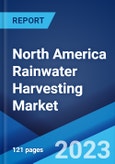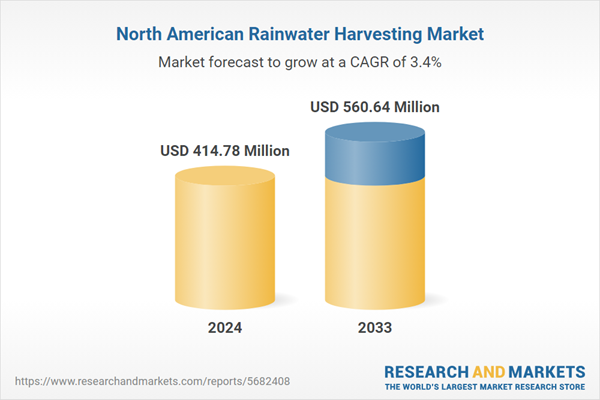As per the North America rainwater harvesting market forecast, water scarcity is a growing concern in many parts of North America, particularly in regions like California, Arizona, and Texas. Climate change has led to more frequent and severe droughts, putting a strain on local water supplies. According to industry reports, abnormal dryness and drought impacted approximately 78 percent of the American population in October 2024, marking the highest percentage recorded in the country's drought monitor's 25-year history. As fresh water becomes scarcer, many communities and even businesses are looking for alternative sources of water. Rainwater harvesting offers a sustainable solution, enabling homes and businesses to collect and store rainwater for non-potable uses such as irrigation, toilet flushing, or cleaning. By utilizing this natural resource, people can reduce their reliance on municipal water systems, particularly during periods of drought.
As environmental concerns grow, more people are becoming conscious of their impact on the planet. From reducing carbon footprints to adopting sustainable practices, consumers and businesses are looking for ways to be eco-friendly. As a result, 76% of companies in the United States now incorporate environmental, social, and governance (ESG) metrics into executive incentive plans, an increase from 52% in 2020. Rainwater harvesting fits perfectly into this mindset. By collecting rainwater, businesses can help reduce the demand for treated water, which often involves energy-intensive processes that contribute to greenhouse gas (GHG) emissions. Furthermore, rainwater is naturally soft and free from chemicals like chlorine, making it a more eco-friendly option for tasks like watering gardens or cleaning. The environmental benefits of rainwater harvesting are making it an attractive solution for people who want to minimize their environmental footprint and live more sustainably.
North America Rainwater Harvesting Market Trends:
Government Incentives and Policies
Recently, federal and state governments in North America have come up with policies and incentives that support water conservation. These may range from tax breaks, grants, or rebates for installing rainwater harvesting systems. For instance, some states offer financial incentives to homeowners and businesses for installing rainwater harvesting systems. These incentives make the investment more affordable as it has a one-time installation cost to be followed by low maintenance. For example, the city of Tucson offers a rainwater harvesting grant and loan program through Tucson Water and SERI, which provides low-income families with grants up to $750 and loans for up to $2,000 in the installation process. Such support from local and state authorities makes more people consider rainwater harvesting as a practical and cost-effective water conservation solution, thus contributing to the North America rainwater harvesting market growth.Rising Water Prices
The prices of water in North America have been increasing over the past few decades. In 2023, the average monthly water service cost in the U.S. was $44.77 for a residential customer using 6,200 gallons. Water prices have surged by 25% over the past six years. These prices reflect an average annual hike of 3.8% for water. Municipal water utilities have increased rates for the maintenance and upgrading of aged infrastructure, supplying clean water, and meeting rising demand. With such rates, households and businesses are forced to find ways of reducing their usage of water; thus, more people are resorting to collecting rainwater to reduce their monthly water bills in areas with very high water rates. Once a rainwater collection system is installed, the cost to utilize rainwater is minimal which is boosting the North America rainwater harvesting market demand.Rapid Technological Advancements
Technological advancements in rainwater harvesting systems have made them user-friendly, efficient, and cost-effective. Modern filtration and purification systems, for example, clean the filtered rainwater so that it can be used for many applications, including drinking in certain cases. Some of these systems include monitoring systems for water levels, quality, and performance, thus minimizing manual interventions. Additionally, other smart controls can correlate with weather forecasts to optimize rainwater collection for heavy rainfall occasions. With all these improvements, rainwater harvesting systems have become easier to rely upon and therefore have become more attractive to residential and commercial users alike. Rainwater harvesting stands to gain much wider acceptance in the near future because advanced technology makes it efficient and user-friendly.North America Rainwater Harvesting Industry Segmentation:
The publisher provides an analysis of the key trends in each segment of the North America rainwater harvesting market, along with forecasts at the country and regional levels from 2025-2033. The market has been categorized based on harvesting method and end-user.Analysis by Harvesting Method:
- Above Ground
- Underground
Analysis by End-User:
- Commercial
- Residential
- Industrial
Country Analysis:
- United States
- Canada
Competitive Landscape:
As per the North America rainwater harvesting market trends, industry leaders are focusing on innovation, strategic partnerships, and expanding their product offerings to capture a larger market share. Companies are enhancing their product portfolios with advanced rainwater collection systems that include features like automated controls, filtration systems, and real-time water quality monitoring. They are also investing in technology to improve system efficiency, such as IoT-enabled devices for remote monitoring and management. Moreover, most companies are working with the local government and municipalities to provide customized solutions for urban and rural areas, encouraging their adoption by offering incentives, grants, and educational resources. Some companies are also teaming up with construction companies and green building developers to implement the rainwater harvesting system in new commercial and residential development projects, which will flourish with the rising trend of green architecture. Besides, market leaders are also working to enhance customer experience by providing maintenance services, installation support, and after-sales assistance, which builds consumer confidence in adopting rainwater harvesting solutions.The report provides a comprehensive analysis of the competitive landscape in the North America rainwater harvesting market with detailed profiles of all major companies.
Key Questions Answered in This Report
1. How big is the rainwater harvesting market in North America?2. What factors are driving the growth of the North America rainwater harvesting market?
3. What is the forecast for the rainwater harvesting market in North America?
4. Which segment accounted for the largest North America rainwater harvesting method market share?
Table of Contents
1 Preface2 Scope and Methodology
2.1 Objectives of the Study
2.2 Stakeholders
2.3 Data Sources
2.3.1 Primary Sources
2.3.2 Secondary Sources
2.4 Market Estimation
2.4.1 Bottom-Up Approach
2.4.2 Top-Down Approach
2.5 Forecasting Methodology
3 Executive Summary
4 Introduction
4.1 Overview
4.2 Key Industry Trends
5 Global Rainwater Harvesting Market
5.1 Market Performance
5.2 Market Breakup by Harvesting Method
5.3 Market Breakup by End-User
5.4 Market Breakup by Region
5.5 Market Forecast
6 North America Rainwater Harvesting Market
6.1 Market Performance
6.2 Impact of COVID-19
6.3 Market Forecast
7 North America Rainwater Harvesting Market: Breakup by Harvesting Method
7.1 Above Ground
7.2 Underground
8 North America Rainwater Harvesting Market: Breakup by End-User
8.1 Commercial
8.2 Residential
8.3 Industrial
9 North America Rainwater Harvesting Market: Breakup by Country
9.1 United States
9.1.1 Historical Market Trends
9.1.2 Market Breakup by Harvesting Method
9.1.3 Market Breakup by End-User
9.1.4 Market Forecast
9.2 Canada
9.2.1 Historical Market Trends
9.2.2 Market Breakup by Harvesting Method
9.2.3 Market Breakup by End-User
9.2.4 Market Forecast
10 SWOT Analysis
10.1 Overview
10.2 Strengths
10.3 Weaknesses
10.4 Opportunities
10.5 Threats
11 Value Chain Analysis
12 Porter’s Five Forces Analysis
12.1 Overview
12.2 Bargaining Power of Buyers
12.3 Bargaining Power of Suppliers
12.4 Degree of Rivalry
12.5 Threat of New Entrants
12.6 Threat of Substitutes
13 Price Analysis
14 Competitive Landscape
14.1 Market Structure
14.2 Key Players
14.3 Profiles of Key Players
List of Figures
Figure 1: North America: Rainwater Harvesting Market: Major Drivers and Challenges
Figure 2: Global: Rainwater Harvesting Market: Value Trends (in Million USD), 2019-2024
Figure 3: Global: Rainwater Harvesting Market: Breakup by Harvesting Method (in %), 2024
Figure 4: Global: Rainwater Harvesting Market: Breakup by End-User (in %), 2024
Figure 5: Global: Rainwater Harvesting Market: Breakup by Region (in %), 2024
Figure 6: Global: Rainwater Harvesting Market Forecast: Value Trends (in Million USD), 2025-2033
Figure 7: North America: Rainwater Harvesting Market: Value Trends (in Million USD), 2019-2024
Figure 8: North America: Rainwater Harvesting Market Forecast: Value Trends (in Million USD), 2025-2033
Figure 9: North America: Rainwater Harvesting Market: Breakup by Harvesting Method (in %), 2024
Figure 10: North America: Rainwater Harvesting (Above Ground) Market: Value Trends (in Million USD), 2019 & 2024
Figure 11: North America: Rainwater Harvesting (Above Ground) Market Forecast: Value Trends (in Million USD), 2025-2033
Figure 12: North America: Rainwater Harvesting (Underground) Market: Value Trends (in Million USD), 2019 & 2024
Figure 13: North America: Rainwater Harvesting (Underground) Market Forecast: Value Trends (in Million USD), 2025-2033
Figure 14: North America: Rainwater Harvesting Market: Breakup by End-User (in %), 2024
Figure 15: North America: Rainwater Harvesting (Commercial) Market: Value Trends (in Million USD), 2019 & 2024
Figure 16: North America: Rainwater Harvesting (Commercial) Market Forecast: Value Trends (in Million USD), 2025-2033
Figure 17: North America: Rainwater Harvesting (Residential) Market: Value Trends (in Million USD), 2019 & 2024
Figure 18: North America: Rainwater Harvesting (Residential) Market Forecast: Value Trends (in Million USD), 2025-2033
Figure 19: North America: Rainwater Harvesting (Industrial) Market: Value Trends (in Million USD), 2019 & 2024
Figure 20: North America: Rainwater Harvesting (Industrial) Market Forecast: Value Trends (in Million USD), 2025-2033
Figure 21: North America: Rainwater Harvesting Market: Breakup by Country (in %), 2024
Figure 22: United States: Rainwater Harvesting Market: Value Trends (in Million USD), 2019-2024
Figure 23: United States: Rainwater Harvesting Market: Breakup by Harvesting Method (in %), 2024
Figure 24: United States: Rainwater Harvesting Market: Breakup by End-User (in %), 2024
Figure 25: United States: Rainwater Harvesting Market Forecast: Value Trends (in Million USD), 2025-2033
Figure 26: Canada: Rainwater Harvesting Market: Value Trends (in Million USD), 2019-2024
Figure 27: Canada: Rainwater Harvesting Market: Breakup by Harvesting Method (in %), 2024
Figure 28: Canada: Rainwater Harvesting Market: Breakup by End-User (in %), 2024
Figure 29: Canada: Rainwater Harvesting Market Forecast: Value Trends (in Million USD), 2025-2033
Figure 30: North America: Rainwater Harvesting Industry: SWOT Analysis
Figure 31: North America: Rainwater Harvesting Industry: Value Chain Analysis
Figure 32: North America: Rainwater Harvesting Industry: Porter’s Five Forces Analysis
List of Tables
Table 1: North America: Rainwater Harvesting Market: Key Industry Highlights, 2024 and 2033
Table 2: North America: Rainwater Harvesting Market Forecast: Breakup by Harvesting Method (in Million USD), 2025-2033
Table 3: North America: Rainwater Harvesting Market Forecast: Breakup by End-User (in Million USD), 2025-2033
Table 4: North America: Rainwater Harvesting Market Forecast: Breakup by Country (in Million USD), 2025-2033
Table 5: North America: Rainwater Harvesting Market: Competitive Structure
Table 6: North America: Rainwater Harvesting Market: Key Players
Table Information
| Report Attribute | Details |
|---|---|
| No. of Pages | 120 |
| Published | August 2025 |
| Forecast Period | 2024 - 2033 |
| Estimated Market Value ( USD | $ 414.78 Million |
| Forecasted Market Value ( USD | $ 560.64 Million |
| Compound Annual Growth Rate | 3.4% |
| Regions Covered | North America |









